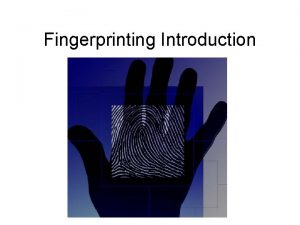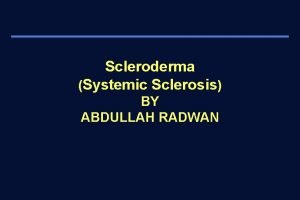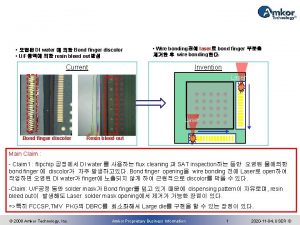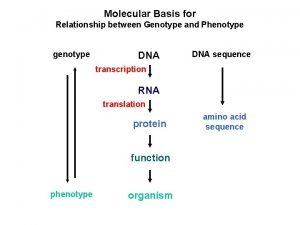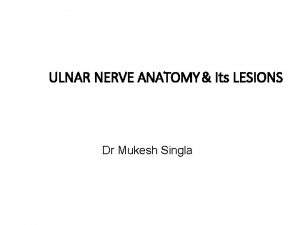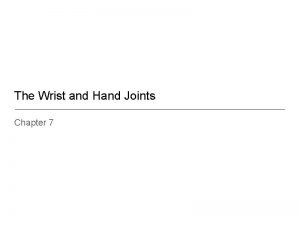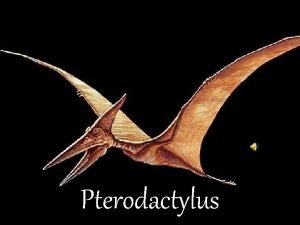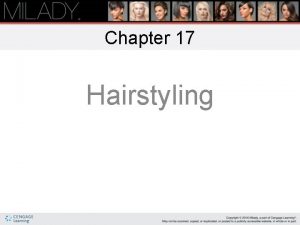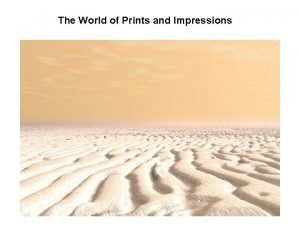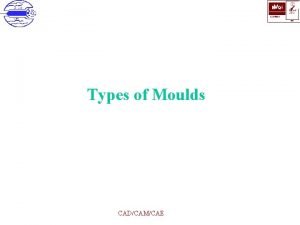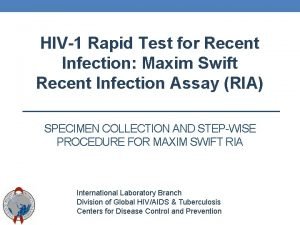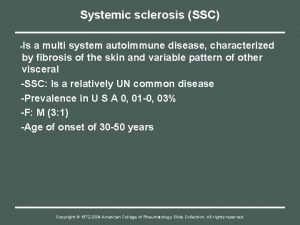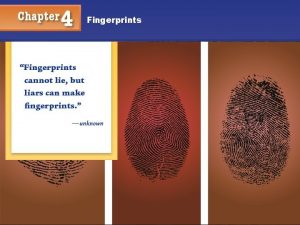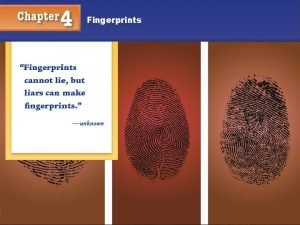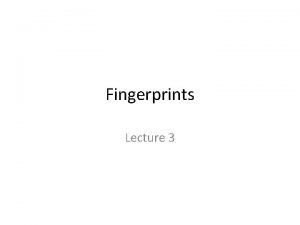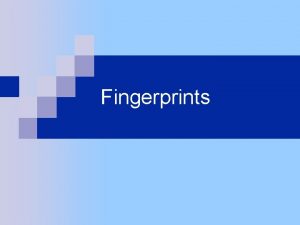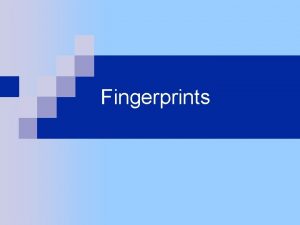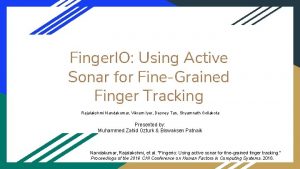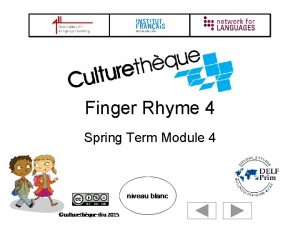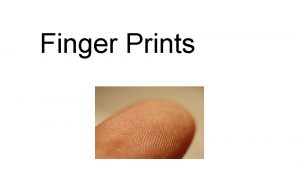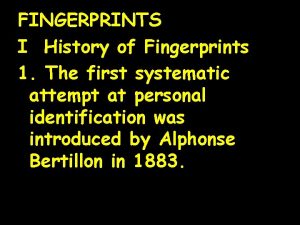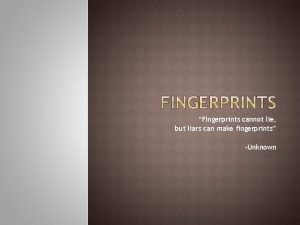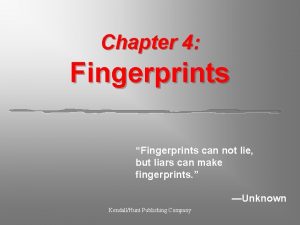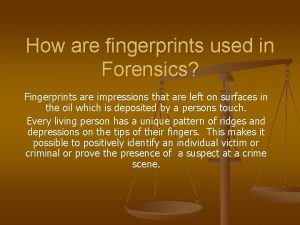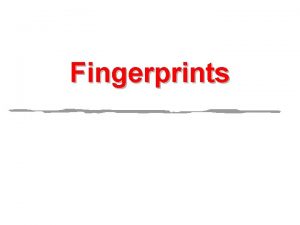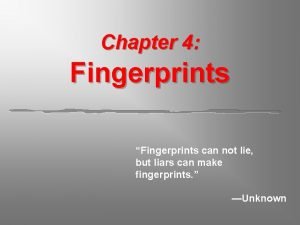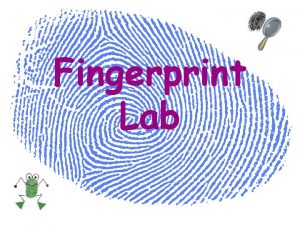FINGERPRINTS WHAT 1 What Are Fingerprints l Finger











































- Slides: 43

FINGERPRINTS WHAT!? 1

What Are Fingerprints? l Finger print = Natural secretions, dirt, and oil l All fingers, toes, feet, and palms are covered in small ridges. l These ridges are arranged in connected units called dermal ridges or friction ridges. l These ridges help us get or keep our 2 grip on objects.

l l l 3 Close up of dermal ridges The big valley is probably a scar The grey spots are sweat coming from sweat pores (false colored)

l 4 NOTICE THE WHITE HOLES IN THE RIDGES. . WHAT ARE THESE

5 Forensic Science: Fundamentals & Investigations, Chapter 6

Formation of Fingerprints l An animal’s external tissue (skin) consists of (a) an inner dermis and (b) an outer epidermis. l Fingerprints begin forming at about the start of the 10 th week of pregnancy. l The creation of fingerprints occurs in a special layer (the basal layer) in the epidermis where new skin cells are produced. l Because the basal layer grows faster than the others, it collapses, forming intricate shapes. 6 Forensic Science: Fundamentals & Investigations, Chapter 6

Characteristics of Fingerprints l The 3 general fingerprint distinctions: 7 ARCH WHORL LOOP About 5% the population About 30% About 65% Forensic Science: Fundamentals & Investigations, Chapter 6 of

Arch An arch has ridges that enter on one side of the finger and cross to the other side while rising upward in the middle. They do NOT have deltas or cores. Types § Plain § Tented Plain arch Kendall/Hunt Publishing Company 8

ARCH l Tented arch Plain arch Kendall/Hunt Publishing Company 9

BEFORE WE BEGIN LOOPS RADIUS ULNA 10

Loop § § Loops must have one delta. Must have one or more ridges entering and exiting from the same side. Types § Radial- loop opens toward radius § Ulnar – loop opens towards ulna Which type of loop is this, if it is on the right hand? Left hand? 11

2 KINDS OF LOOPS l Opens toward pinky (ulnar bone) Kendall/Hunt Publishing Company l Opens toward thumb (radius bone) 12

Whorl § § Whorls have at least two deltas. 4 Types 1. 2. 3. 4. Plain whorl Central Pocket whorl Double Loop whorl Accidental whorl Plain whorl 13

WHORL TYPE 1 (PLAIN WHORL) l Plain whorl l Has a core two deltas between which, when an imaginary line is drawn, at least one recurving ridge within the inner pattern area is cut or touched. 14

WHORL TYPE 2 (CENTRAL POCKET WHORL) l Central pocket whorl – – – Loop like but the loop doesn’t have 1 complete entrance to exit A Tiny core two deltas between which, when an imaginary line is drawn, NO recurving ridge within the inner pattern is cut or touched. 15

√ √ ç √ Kendall/Hunt Publishing Company √ ç √ 16

WHORL TYPE 3 (Double Loop Whorl) l Double loop whorl – – – 2 deltas two separate loops 17

WHORL TYPE 4 (Accidental Whorl) l ACCIDENTAL WHORL – – – 2 (or more) deltas FINGERPRINTS GONE WILD! 18

Characteristics of Fingerprints l. A ridge count is made from the center of the core to the edge of the delta. 19 Forensic Science: Fundamentals & Investigations, Chapter 6

Ridge Characteristics Minutiae—characteristics of ridge patterns § § § § § Ridge ending Dot Bifurcation/fork Double bifurcation Trifurcation Bridge Island/short ridge Enclosure Spur Delta Kendall/Hunt Publishing Company 20

Fingerprint Minutiae 21 Kendall/Hunt Publishing Company

22 Forensic Science: Fundamentals & Investigations, Chapter 6

Types of Fingerprints There are 3 types of prints that investigators look for at crime scenes: 1. Patent fingerprints are visible prints transferred onto smooth surfaces by blood or other liquids. 2. Plastic fingerprints are indentations left in soft materials such as clay or wax. 3. Latent fingerprints are not visible but made so by dusting with powders or the use of chemicals. 23 Forensic Science: Fundamentals & Investigations, Chapter 6

Name that print l. Latent 24 print Forensic Science: Fundamentals & Investigations, Chapter 6

Name that print l. Plastic print 25 Forensic Science: Fundamentals & Investigations, Chapter 6

Name that print l. Patent 26 print

Name that print l. Plastic 27 print Forensic Science: Fundamentals & Investigations, Chapter 6

Name that print l. Patent 28 print Forensic Science: Fundamentals & Investigations, Chapter 6

Fingerprint Forensic FAQs l How are latent fingerprints collected? 29

Ninhydrin Fingerprint 30 Kendall/Hunt Publishing Company

Cyanoacrylate Fingerprints Kendall/Hunt Publishing Company 31

Silver nitrate l . 32

Iodine Fingerprint Kendall/Hunt Publishing Company 33

New technology l AFIS – automated fingerprint identification system Kendall/Hunt Publishing Company 34

Fingerprint Forensic FAQs l Can fingerprints be erased? No, if, for example, they are removed with chemicals, they will grow back. l Is fingerprint identification reliable? Yes, but analysts can make mistakes. l Is fingerprint matching carried out by computers in a matter of seconds? No, but the FBI’s Integrated Automated Fingerprint Identification System (IAFIS or AFIS) can provide a match in 2 hours for the prints in its Master File. 35 Forensic Science: Fundamentals & Investigations, Chapter 6

The Future of Fingerprinting l New scanning technologies and digitally identifying patterns may eliminate analytical mistakes. l Trace elements of objects that have been touched are being studied to help with the identification of individuals. l To help with identification, other physical features such as eyes and facial patterns are also being studied. 36 Forensic Science: Fundamentals & Investigations, Chapter 6

. . . . Summary l Fingerprints have long been used for identification, and in l l l 37 the mid-1800 s were recognized as unique to each person. Three main groups include arches, whorls, and loops. Basic analysis includes looking for cores, deltas, and making a ridge count. Investigators search for patent, plastic, and latent prints. Dusting with powders or using special chemicals can make latent fingerprints visible. New developments may eliminate errors by analysts. Forensic Science: Fundamentals & Investigations, Chapter 6

38 Forensic Science: Fundamentals & Investigations, Chapter 6

Chapter 6 Fingerprints By the end of this chapter you will be able to: l discuss the history of fingerprinting l describe the characteristics of fingerprints and l l fingerprinting minutiae explain when and how fingerprints are formed describe what causes fingerprints to be left on objects identify the basic types of fingerprints describe how criminals attempt to alter their fingerprints All Rights Reserved South-Western / Cengage Learning © 2009 39 Forensic Science: Fundamentals & Investigations, Chapter 6

Chapter 6 Fingerprints By the end of this chapter you will be able to: l determine the reliability of fingerprints as a means of l l l 40 identification describe the Integrated Automated Fingerprint Identification System (IFAIS) explain how fingerprint evidence is collected describe the latest identification technologies determine if a fingerprint matches a fingerprint on record use the process of lifting a latent print Forensic Science: Fundamentals & Investigations, Chapter 6

Historical Development 41 1. The oldest known documents showing fingerprints date from third century B. C. China. 2. In ancient Babylon (dating back to 1792 -1750 B. C. ), fingerprints pressed into clay tablets marked contracts. 3. The earliest written study (1684) is Dr. Nehemiah’s paper describing the patterns he saw on human hands under a microscope, including the presence of ridges. 4. In 1788, Johann Mayer noted that the arrangement of skin ridges is never duplicated in two persons. He was probably the first scientist to recognize this fact. Forensic Science: Fundamentals & Investigations, Chapter 6

Historical Development 5. Nine fingerprint patterns were described in 1823 by Jan Evangelist Purkyn. 6. Sir William Herschel (shown at the right), in 1856, began the collection of fingerprints and noted they were not altered by age. 7. Alphonse Bertillon created a way to identify criminals that was used in 1883 to identify a repeat offender. In 1888, Sir Francis Galton (shown at the right), and Sir Edmund Richard Henry, developed the fingerprint classification system that is still in use in the United States. 8. 42 Forensic Science: Fundamentals & Investigations, Chapter 6

Historical Development 9. In 1891, Iván (Juan) Vucetich adding all ten fingerprint impressions. 10. Beginning in 1896, Sir Henry (mentioned in the last entry on the previous slide), created a system that divided fingerprints into groups. Along with notations about individual characteristics, all ten fingerprints were imprinted on a card (called a ten card). 43 Forensic Science: Fundamentals & Investigations, Chapter 6
 Antigentest åre
Antigentest åre Palm up and palm down finger rest
Palm up and palm down finger rest The three principles of fingerprints
The three principles of fingerprints Five finger summary strategy
Five finger summary strategy Matt audette finger
Matt audette finger Acrolysis definition
Acrolysis definition Two lines that run parallel or nearly parallel
Two lines that run parallel or nearly parallel Sunscreen two finger rule
Sunscreen two finger rule Ligament de hasselback
Ligament de hasselback Resin bleed out
Resin bleed out Fingerprint poem
Fingerprint poem Tmj examination in orthodontics
Tmj examination in orthodontics Mallet finger orthobullets
Mallet finger orthobullets 5th digit finger
5th digit finger Ankle tape cutter
Ankle tape cutter Abductor pollicis brevis
Abductor pollicis brevis Zinc finger structure
Zinc finger structure Finger network sdn bhd
Finger network sdn bhd Finger tip unit
Finger tip unit Thumb up test
Thumb up test What is finger correction
What is finger correction Finger opposition
Finger opposition Counter finger
Counter finger Camellotte
Camellotte The qualities felt with the finger tongue palate or teeth
The qualities felt with the finger tongue palate or teeth Sixtinische madonna 6 finger
Sixtinische madonna 6 finger Mastoid tenderness 3 finger test
Mastoid tenderness 3 finger test Anatomie oog oefenen
Anatomie oog oefenen Suspend
Suspend Couvillion meaning
Couvillion meaning Start sun protection
Start sun protection 4 pin curl bases and their uses
4 pin curl bases and their uses Finger tip unit
Finger tip unit Keyboard finger positioning
Keyboard finger positioning Three finger test for mastoid tenderness
Three finger test for mastoid tenderness First impressions finger print
First impressions finger print Finger lakes formation
Finger lakes formation The magic finger ducks
The magic finger ducks Finger cam actuation formula
Finger cam actuation formula Capillary puncture finger
Capillary puncture finger Finger names medical
Finger names medical Mauskopf scleroderma
Mauskopf scleroderma 5 function of skeletal system
5 function of skeletal system C69 chord
C69 chord


